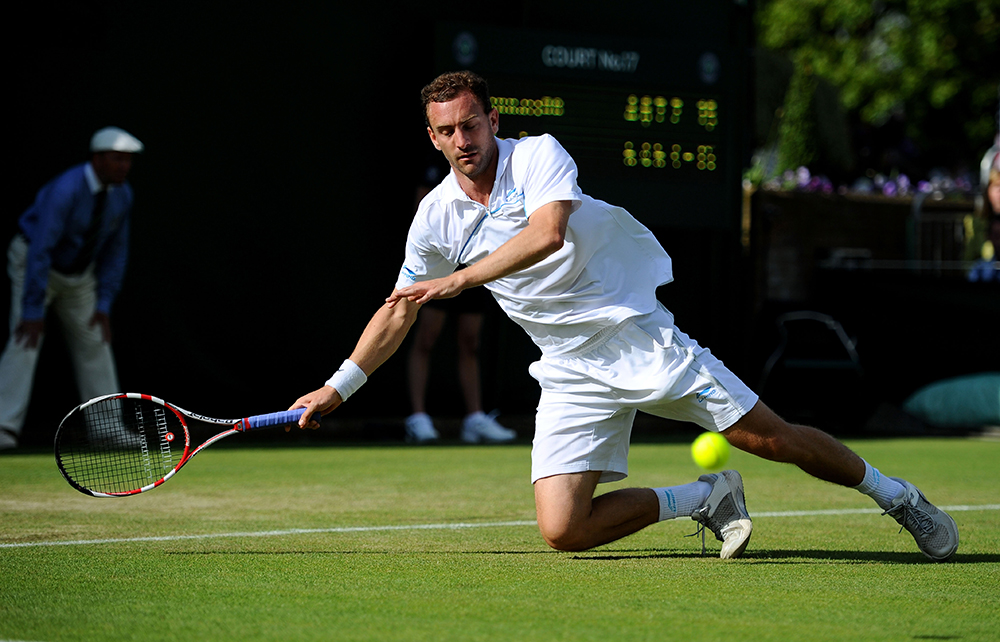Wimbledon’s starched whites, manicured flower beds and hushed silence enable tennis to present itself as a genteel sport. But Wimbledon only represents tennis in the way that an Olympic 100m final represents athletics. It is the best players in the best setting for a brief period. Actual tennis, the day-to-day life of a regular player on the circuit, is very different. It is relentless, stingy and unsentimental. The most surprising thing about The Racket, Conor Niland’s bruising account of his career as a good (but not great) tennis player, is that he emerges with both his sanity and his compassion intact.
Tennis is not an easy game to break into. Niland, born in Birmingham but brought up in Ireland, would appear to have had a fortunate start: his parents were sporty and his older sister, Gina, had some success as a junior player. The Nilands built a court in their garden for daily practice. But, as Conor discovers, even these leg-ups left him trailing in the wake of the true elite. Aged 13, he was being trained by his dad on their home court for an hour after school. At the same stage, Rafael Nadal was hitting balls with Carlos Moya, a former world number one. Niland later wins a scholarship to Millfield, a private school with an excellent reputation for producing athletes. He later notes that Roger Federer, Andy Murray and Nadal all left school at 16 to focus purely on tennis.
For budding professionals, the promised land is the ATP Tour, a series of lucrative, well-organised tournaments, contested by men ranked in the top 100. Below that are two other sets of competitions: the Challenger Tour (for those ranked between 100 and 300) and the Futures, which is home to ‘tennis’s vast netherworld of more than 2,000 true prospects and hopeless dreamers’. Winning matches at these events earns ranking points, and the goal is to climb the rankings faster than everyone else.
Life is infinitely harder at the bottom. Players must book their own travel, pay for their own coaches (if they have one) and source their own equipment. Often the tournaments seem actively hostile to their participants. Niland wastes untold hours in hotel rooms waiting to play because organisers can’t (or won’t) tell him with any precision when his games are due to start. He is clearly good company, but he admits he ‘made virtually no lasting friendships on tour through my seven years’. Although he is surrounded by young guys of the same age doing the same thing, his potential mates are also his direct competition and no one wants inadvertently to give a rival a boost by being kind. Also, the money is dire. The winner of a Futures event might get $1,000, from which he has to deduct tax, travel and expenses:
Surviving on the Futures and Challenger tournaments isn’t just about being good at tennis. It’s about being able to cope with the strange bedfellows of regular boredom and constant uncertainty. Not many succeed.
Yet Niland does. Although he is unsparing in his depiction of the drudgery of tennis and is regularly badgered by friends from home wondering how long he is going to stick at it, he is completely devoted to the sport. That his dedication never wavers even as he realises that he lacks the skills to compete with the very best is even more remarkable. He is able to cope with the disappointment of stumping up for a long-haul flight, only to lose in the first round of an unknown tournament. All the while he retains enough focus gradually to improve his set-up. He wins his first Futures title, then his first Challenger competition, and becomes the first Irish man to compete in a Grand Slam qualifier in years.
Eventually, he cracks Grand Slam qualifying, too. On winning the match that puts him in the main draw of Wimbledon for the first time, he collapses. ‘All that tension leaving the body at once will do that to a person,’ Niland explains. His exploits at Wimbledon 2011 and the subsequent US Open are genuinely dramatic.
In 2012, suffering from a deteriorating hip injury that he could not afford to treat, Niland decides that he is done. It is a moment of supreme anticlimax:
I didn’t inform anyone at the ATP of my retirement. I didn’t sign anything. I just stopped turning up. Nobody from the tour contacted me to ask where I was. There were hundreds of guys ready to fill my place.
Ultimately, tennis needs Roger Federer and Novak Djokovic and Carlos Alcaraz. It did not need Conor Niland. In a sentence that ought to chill the blood of the game’s administrators, Niland realises that ‘my day-to-day life genuinely improved when I quit tennis’. He will not be the only one.







Comments